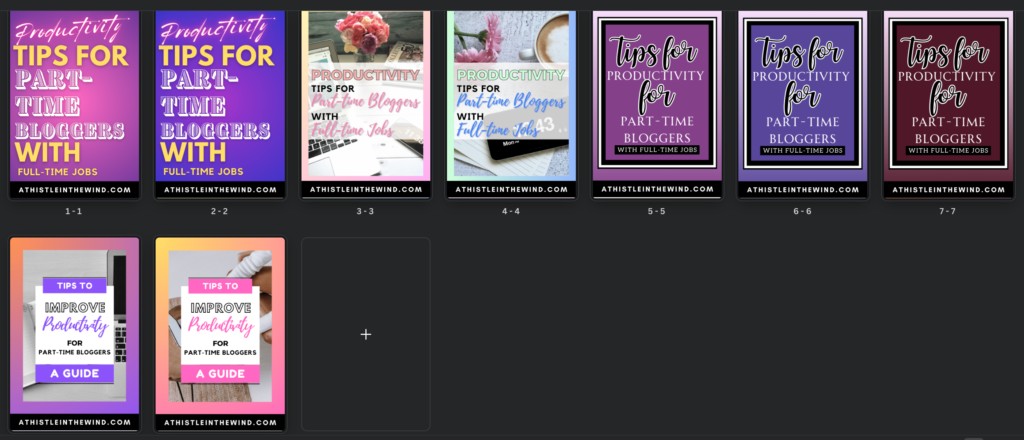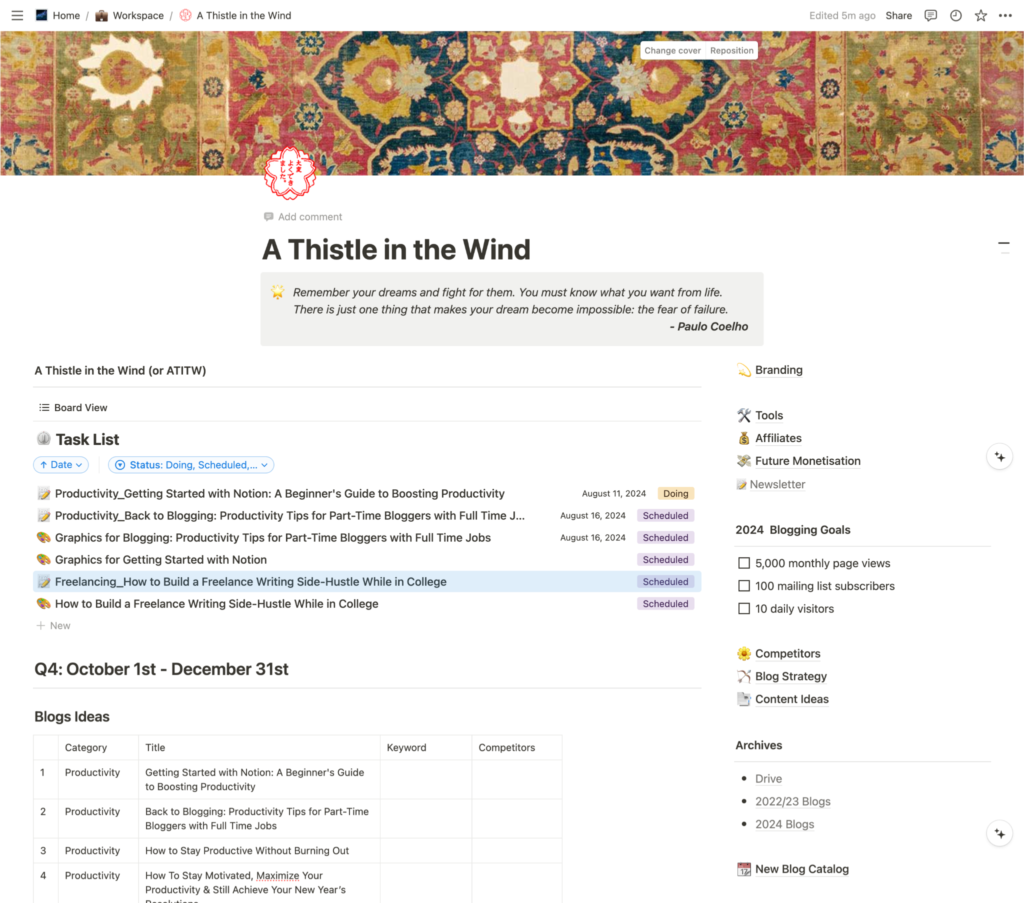Back to Blogging: Productivity Tips for Part-Time Bloggers with Full Time Jobs

I think it’s safe to say that this blog is a perfect example of how consistency is hard for bloggers. There are times where I’ll post on a weekly or bi-weekly basis, before falling off the wagon completely. In part, it’s due to the fact that this blog has always been on the back burner in terms of priority. That changed this year; I’ve been (infrequently) blogging to see how I can get traffic and improve my following.
So far, it’s worked. But if you’re someone who’s interested in blogging full-time, being inconsistent is not an option. If you’ve recently started a blog, or you’re thinking about starting one, chances are that you still have a full-time job.
And let’s be honest, after you’ve finished your day shift, you won’t necessarily have the energy to crank up 3000+ words. Even if you manage to force yourself to do so, you will burn out eventually. And that can be a huge blow to your morale, and can stop you from blogging for a while.
So, what can you do about this?
Well, I do happen to know one or a hundred things about falling into this doom spiral multiple times. In my experience, the best way to ensure that you’re prioritising your blog is better time management. Part-time bloggers, in particular, have to be smart. We need to make sure that we’re doing our best at our full-time jobs, building up our blogs to eventually become full-time bloggers, and have the energy and time to wind down and relax too.
All of this is possible, but it requires some adjustments. That is why I decided to write about it. In this blog, we’ll look at productivity tips that can help you maintain your blog, while balancing a full-time job.
NOTE: This page contains affiliate links. This means that if you make a purchase through my links, I will receive a commission, at no cost to you.
Importance of Time Management for Part-Time Bloggers
I’ve talked about managing a schedule for freelancers in the past, and I think you can pick up some valuable tips from there. But that’s like, the baseline of how new bloggers should approach things. Let’s be honest: balancing a full-time job with blogging is no joke. The demands of both can feel overwhelming, leading to burn out and a feeling of not doing enough. Of not being good enough. After all, some of the best bloggers in any niche started with full-time jobs. No blogger just posted a blog one day and BAM! ended up with a full-time career. So, if others could do it, you should be able to do it too, right?
Well, yes and no. See, this mindset can actually be more harmful than you’d think. You need to understand that everyone’s way of doing things is different. There a multitude of factors that can influence the way you work. But time management is a skill anyone can pick up, quite easily so if I’m being honest. It’s all about knowing what to do, when and having a set end goal in mind.
Time management isn’t just about juggling tasks—it’s about making the most of your limited hours to ensure you meet your professional and personal goals without burning out. That’s where productivity comes into the mix. The reason I’m talking about productivity tips is because you can incorporate these, no matter what your daily routine looks like. Let’s look at this in detail.
Productivity Tips for Part-Time Bloggers to Super Charge Your Output
1. Set Clear Goals for Your Blog

Before you begin doing anything, it’s super important to get your goals clear. What do you hope to achieve from your blog? A goal can be as simple as “I want traffic on my site” to “I want 1,000 monthly visitors, for at least 2 months, by December 31.” It really depends on what you plan to achieve. For me personally, this year’s are simple. By December 31, I want:
- 5,000 monthly page views
- 50 mailing list subscribers
- 10 daily visitors
It’s not the craziest list, and extremely conservative. In fact, in terms of daily visitors to the site, we’re actually at 12 — 15 visitors right now. But that’s because I like being realistic. I always get super busy in October until Christmas because, well, it’s the last quarter of the year. There’s nothing wrong with being conservative, but don’t sell yourself short. I haven’t launched my newsletter yet so the real challenge for me would be the mailing list.
So, how do you do this effectively?
Set weekly and monthly blogging goals
Start by setting weekly or monthly blogging goals to keep your progress on track. These goals could include the number of blog posts to publish, research topics to explore, or engagement metrics to improve. Defining these milestones will help you stay consistent and measure your growth.
Break larger goals into smaller tasks
Next, break larger goals into smaller tasks to make them more manageable. For example, instead of thinking about writing an entire blog post, break it down into tasks like researching, drafting, editing, and publishing. This approach prevents you from feeling overwhelmed and makes it easier to fit blogging into your busy schedule.
Use a content calendar to plan ahead
A well-structured content calendar allows you to visualize upcoming content and deadlines, which helps reduce stress and keeps you organized. By knowing what needs to be done and when, you can better balance your blogging responsibilities with other commitments, ensuring steady progress toward your goals. If you’re not sure how to proceed with a content calendar, read my blog:
2. Prioritize and Streamline Your Tasks
Prioritizing your tasks is essential to boosting productivity, especially when balancing multiple responsibilities. By focusing on what’s truly important, you can make steady progress towards your goals.
To begin, identify the essential blogging activities that contribute the most to your goals. These might include content creation, keyword research, and promoting posts on Pinterest. Once you’ve established your priorities, you can start scheduling your day and allocating time for each task. This ensures that you’re not just busy, but productive.
Focus on High-Impact Tasks First to Maximize Efficiency
When your to-do list is long, prioritize high-impact tasks first. These are the tasks that have the greatest effect on your blog’s growth, such as writing new posts or optimizing for SEO. By addressing these activities early in your day, you ensure that even if other tasks pile up, the most crucial work is done.
3. Do Batch Content Creation to Save Time

Batch content creation is a powerful productivity technique that allows bloggers and content creators to save time and maintain consistency. I like to divide my free time into three categories: research, writing and design. I take a day to plan and research a couple of blogs, take my weekends to write them and dedicate one day to create Pinterest pins. By dedicating specific days or blocks of time solely to content creation, you can focus deeply and produce more in less time. Here’s how you can also do this:
Brainstorming and Planning
Start by brainstorming and developing content ideas, followed by outlining your blog posts in advance. This pre-planning step gives you a clear roadmap when it’s time to sit down and batch content, speeding up the creation process.
Blocks of Time Solely for Content Creation
To streamline your workflow, plan content creation days where your sole focus is writing, editing, or designing. These uninterrupted sessions can help you churn out more content without the distractions of daily tasks.
Schedule Posts in Advance to Maintain Consistency
Scheduling your posts in advance ensures that your blog or social media remains active, even during busy periods. It’s a great way to build a consistent presence online while managing other commitments.
Repurposing Content
Repurpose existing content by transforming it into new formats, such as turning a blog post into a video, infographic, or social media post. This maximizes your efforts and keeps your content fresh across various platforms.
4. Incorporate Productivity Tools and Technology

You can significantly improve your blogging productivity by incorporating the right tools and technology into your workflow. With so many tasks to juggle, productivity tools can streamline the process and help you manage your time effectively.
Use Tools Like Notion to Organize Ideas and Drafts
Staying organized is key to maintaining momentum as a blogger. Notion allows you to track ideas, outline drafts, and store resources all in one place. It acts as an all-in-one workspace where you can create templates, manage projects, and collaborate with others. In fact, I use Notion for all aspects of my life, not just for blogs. It helps me reduce mental clutter, ensuring that I stay on top of my game. Get Notion today and enhance your productivity!
Automate Repetitive Tasks, Such as Social Media Posting, to Save Time
Automation is another powerful way to boost productivity. Managing social media manually can be time-consuming, but with automation tools like Hootsuite or Tailwind, you can schedule posts across various platforms in advance. This reduces the need to constantly log in and post updates, freeing up more time for writing and content creation. By automating repetitive tasks, you can focus on what matters most — crafting valuable blog posts that engage your audience.
5. Leverage Your Downtime
One of the most effective ways to increase your productivity is by leveraging your downtime. Whether it’s during lunch breaks, commutes, or quiet evenings, these pockets of time can be turned into valuable moments for your blog.
Use These Moments for Brainstorming, Outlining, or Even Editing Blog Posts
Instead of scrolling through social media or zoning out, use this time wisely. Commuting to work? If you’re not driving, take advantage of that time to review drafts, research your topics, or even edit blog posts. I like to utilise my commute hours, as I’ve mentioned in the previous life update, to write. The key is to break down tasks into smaller chunks that can fit into your available time slots. This way, you’re continually moving forward, even in short spurts of time.
Listen to Podcasts or Read Articles to Stay Inspired and Generate Ideas
To keep your creativity flowing, fill your downtime with inspiration. Podcasts related to your niche can be an excellent source of ideas and learning. Likewise, reading industry articles during spare moments can spark new content ideas. I’m subscribed to a multitude of newsletters from industry leaders like Semrush, WebFX and others just to know what’s happening in the industry. Fun fact: most of my SEO articles are inspired by Semrush’s treasure trove of information on the more nitty gritty details that other blogs tend to ignore.
6. Delegate and Outsource When Necessary
As a blogger, I’ll admit that I like to do things myself. But sometimes, it’s perfectly fine not to do so. Delegating and outsourcing tasks can be game-changing for those seeking to improve productivity.
The key is to recognize which tasks are essential to your role and which can be passed on to others. Outsource non-essential tasks like scheduling, or graphic design to professionals who can handle these areas more efficiently. Platforms like Upwork or Fiverr offer a variety of skilled freelancers to support you at affordable rates.

How to Stay Motivated and Avoid Burn Out
Of course, even with these productivity tips, it can still be really hard to stay motivated. In my case, I struggle with burn out. I get tired and sleep isn’t something that you can compromise on. Being productive is more about being wise with the time you spend. You can’t work 18 hours a day straight. That’s just not going to happen.
However, with thoughtful planning and a focus on productivity tips, you can stay motivated and avoid burnout. Here are a few key approaches to maintain balance and productivity while preserving your energy.
1. Set Realistic Expectations to Avoid Overloading Yourself
The first step in avoiding burnout is setting realistic expectations. It’s important to be honest about what you can achieve within the constraints of your time and energy. While it’s tempting to take on as much as possible (trust me, I do this alll the time), overloading yourself with tasks can lead to frustration and exhaustion. Instead, start by setting small, attainable goals, and build from there.
2. Block Time for Tasks
Blocking out time for specific tasks has already been mentioned, but let’s explore how this productivity tip can be put into action effectively. Time-blocking ensures that each task gets its dedicated attention. Begin by identifying your most productive times of day and scheduling your toughest or most important tasks during those periods. When time-blocking, set aside blocks for your primary responsibilities, as well as breaks (which I’ll talk about shortly) to give your mind time to rest. Having structured blocks prevents tasks from bleeding into one another and helps you stay on track.
3. Schedule Breaks (It’s Super Important!)
Scheduling breaks is essential for maintaining long-term productivity. When you’re balancing two roles, it can feel like there’s never enough time to stop. However, pushing through without breaks can quickly deplete your mental energy. Use the Pomodoro technique—25 minutes of work followed by a 5-minute break—or schedule longer breaks after completing a series of tasks. These pauses give your brain a chance to recharge and reduce the likelihood of burnout.
4. Minimize Distractions
Again, minimizing distractions has already been highlighted in the productivity tips mentioned above, but it’s worth digging into further.
Identify your biggest distractions and once identified, take actionable steps to minimize or eliminate them. For instance, use apps that block notifications during work hours, or create a distraction-free workspace that encourages focus.
5. Prioritize Self-Care to Maintain Long-Term Productivity
Ensure you’re getting enough sleep, eating well, exercising, and engaging in activities that help you relax and unwind. By taking care of yourself, you’re setting a foundation for sustainable productivity and avoiding burnout.
6. Improve and Refine
Finally, regularly assess and refine your approach. No two days are the same, and productivity can fluctuate depending on a variety of factors. Continuously evaluate what’s working and what’s not, and make adjustments accordingly. Remember, improvement is a gradual process, and the more you refine your approach, the better you’ll be at maintaining motivation and avoiding burnout.

Bonus: Here’s a Proven Productivity Booster That You Can Implement Today!
There is one thing you can do to improve your productivity today: create a dedicated workspace. Studies have shown that creating a focused work environment is crucial to maximize your productivity. When you have a specific area set aside for blogging, it helps signal to your brain that it’s time to get down to work. This separation between work and leisure can significantly boost your concentration and efficiency.
Ensure this space is free from distractions and clutter to maintain a clear, organized environment. This way, when you sit down at your designated workspace, you’ll be in the right mindset to tackle your blogging tasks with renewed focus.
Keep Moving Forward: Consistency Always Wins!
These productivity tips can help you supercharge your blogging process, even with a full-time job. I want to end this blog by saying that it’s going to be hard. Trust me, I know. I’ve failed to maintain a consistent schedule, and it’s OK. As you long as you have your priorities sorted, and you follow even one of these productivity tips, you should be good to go. Just know that you won’t become a full-time blogger overnight, or even for years, but the only way you can ensure that you get there is if you don’t call it quits.



3 Comments
Joanna
Another great productivity would be to wake up early in the morning, and sleep early too. There’s a lot you can do when you’re well rested!
athistleinthewind
Agreed! I have a blog on the topic too: https://www.athistleinthewind.com/advice-for-freelancers-on-the-importance-of-a-morning-routine/
Dana
Great post, Sura!